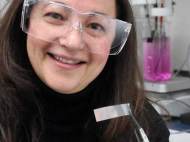Batteries with titanium dioxide nanotubes charge pretty fast
 A team of researchers at the U.S. Department of Energy’s Argonne National Laboratory, discovered that nanotubes composed of titanium dioxide can switch their phase as a battery is cycled, gradually boosting their operational capacity. Laboratory tests showed that batteries produced with this material could be recharged up to half of their original capacity in less than 30 seconds.
A team of researchers at the U.S. Department of Energy’s Argonne National Laboratory, discovered that nanotubes composed of titanium dioxide can switch their phase as a battery is cycled, gradually boosting their operational capacity. Laboratory tests showed that batteries produced with this material could be recharged up to half of their original capacity in less than 30 seconds.
“We did not expect this to happen when we first started working with the material, but the anode spontaneously adopted the best structure”, said Tijana Rajh, Argonne nanoscientist who co-led the research. “There’s an internal kind of plasticity to the system that allows it to change as the battery gets cycled.”
Led by Rajh and battery expert Christopher Johnson, the researchers found that switching out conventional graphite anodes for ones composed of the titanium nanotubes enable the batteries to become more efficient. Titanium dioxide is an amorphous material, and amorphous materials generally lack the special electronic properties of highly ordered crystalline materials.
“We started with a material that we never thought would have provided a functional use, and it turned into something that gave us the best result possible”, said Hui Xiong, Argonne nanoscientist who worked with Rajh to develop the new anode material.
By combining state-of-the-art nanofabrication techniques with high-intensity X-rays to characterize the nanotubes, the Argonne researchers were able to quickly observe this unusual behavior. Unlike most of the known battery materials which start out as highly crystalline and pulverize to an amorphous state upon cycling, the titanium dioxide battery cycle of several charges and discharges made its internal structure orient itself in a way that dramatically improved the performance of the battery.
The video above shows that formation of highly ordered structure is actually spontaneous if the conditions for cycling are right. This simulation shows the evolution of a long-range order, as revealed by the formation of regularly ordered layers of oxygen (red circles). These well-defined layers of oxygen are separated by layers of mixed metal (Ti, blue, and Li, green) atoms that are randomly distributed.
One of the other researchers in Rajh’s group, Sanja Tepavcevic, has adopted a similar approach to make a self-improving structure for a sodium-ion nanobattery.
“This is highly unusual material behavior”, said Jeff Chamberlain, an Argonne chemist who leads the laboratory’s energy storage major initiative. “We’re seeing some nanoscale phase transitions that are very interesting from a scientific standpoint, and it is the deeper understanding of these materials’ behaviors that will unlock mysteries of materials that are used in electrical energy storage systems.”
Having anodes composed of titanium dioxide instead of graphite also improves the reliability and safety of lithium-ion batteries. The researchers from Argonne National Laboratory claim that they have conducted tests on titanium anodes where they proved to be exceptionally safe, whereas lithium can cause a dangerous chain reaction in batteries known as thermal runaway – a process where increased temperature causes release of energy that further increases temperature, causing batteries to overheat or even explode.









Very useful for charging with Renewables.
Dr.A.Jagadeesh Nellore(AP),India
E-mail: anumakonda.jagadeesh@gmail.com